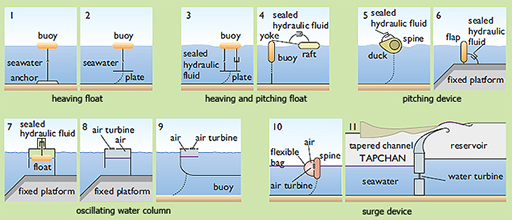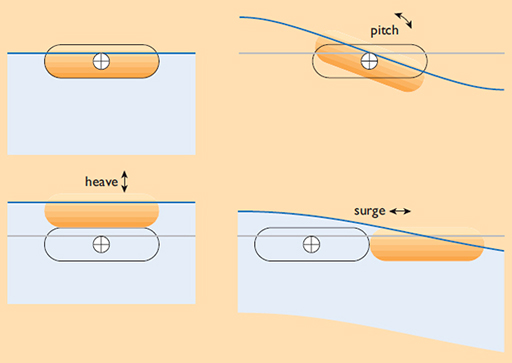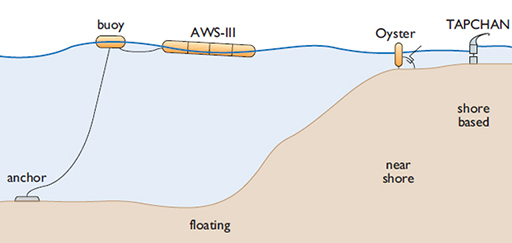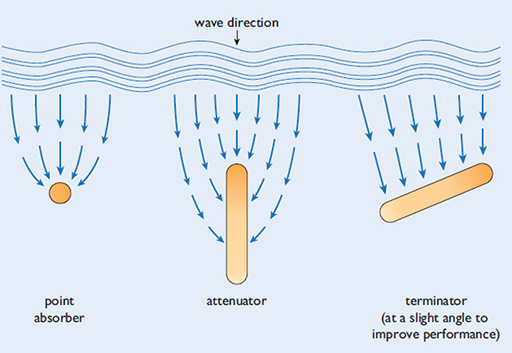3 Wave energy technologies
To capture energy from sea waves it’s necessary to intercept the waves with a structure that will react in an appropriate manner to the forces applied to it by the waves. In a shore-mounted device the structure is firmly fixed to the seabed and the waves make water move in a useful way.
For other types of device some part of the structure may be fixed, perhaps anchored to the seabed, but another part may be a float that moves in response to the waves by pulling against the anchor. In this case the relative motion between the anchor and the float provides the opportunity to extract energy.
Very loosely tethered floating structures can also be employed, but a stable frame of reference must still be established so that the ‘active’ part of the device moves relative to the main structure. This can be achieved by taking advantage of inertia, or by making the main structure large enough to span several wave crests, hence remaining reasonably stable in most sea states.
A body in the sea subject to waves can respond to six types of movement. These are sway, roll and yaw, not generally harnessed in wave energy conversion technology. Three more, harnessed to varying degrees in most wave energy converters, are:
- pitch – waves cause the device, or part of it, to rotate about its axis.
- heave – waves cause the device to rise and fall vertically, though these devices have too high a natural frequency to be particularly effective.
- surge – waves cause the device to move horizontally backwards and forwards, Theoretically, surging motions are twice as energetic as heaving ones, making it preferable to harness this component of waves.
Economics demands that a device should survive at sea for at least five years. During that time some of its components will have to execute 15 to 30 million cycles, placing severe constraints on material selection and strain levels. A structure designed to operate at a particular wave power density will also have to endure storms with power densities ten to thirty times higher than the operating value.
The physical size of the structure of a wave energy converter is a critical factor in determining its performance. The appropriate size can be estimated by considering the volume of water involved in the upper particle orbits in a wave. In most circumstances a wave energy converter will have to have a swept volume similar to this volume of water in order to capture all of the energy contained in the wave. The precise physical size and shape of each device will be governed by its mode of operation, but as a rough guide the swept volume must be of the order of several tens of cubic metres per metre of device width.
There are many different configurations of wave energy converter. Several ways of classifying them have been proposed:
1. Classified by mode of operation (Figure 9)

2. Classified by device location – usually in three general classifications (shown in Figure 9):
- fixed to the seabed, generally in shallow water (eg TAPCHAN)
- tethered in intermediate depths (eg Oyster)
- floating offshore in deep water (eg AWS-III).
These three named devices are described in the next section.
3. Classified by geometry and orientation (see Figure 11). Here the options are:
- terminators
- attenuators
- point absorbers.
We’ll take a closer look at fixed devices in the next section, and for brevity the various wave energy devices described are those developed or installed in or around the British Isles.



